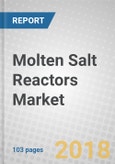The molten salt reactors market is segmented into the following categories:
- By nuclear fuel type: thorium, uranium and plutonium.
- By end-use: power and energy, oil and gas, shipping and other industries.
- By region: North America is segmented into the U.S., Canada and Mexico; Europe is segmented into France, Italy, Germany, the U.K., Russia and the rest of Commonwealth Independent States (CIS); Asia-Pacific (APAC) is segmented into China, Japan, Taiwan, South Korea and others; and the rest of the world (ROW) covers the Middle East, Africa and South America.
- Estimated values used are based on manufacturers’ total revenues. Projected and forecasted revenue values are in constant U.S. dollars, unadjusted for inflation.
In addition to industry and competitive analysis of the molten salt reactors market, this report also includes a patent analysis and a listing of company profiles for key players in the molten salt reactors market.
The Report Includes:
- 79 tables
- An overview of the global markets for molten salt reactors
- Analyses of global market trends, with data from 2016, 2017, and projections of compound annual growth rates (CAGRs) through 2022
- A look at the various nuclear fuel types of molten salt reactors and the market dynamics of each end-use
- Examination of key trends related to types of nuclear fuel and end-use applications that shape and influence the molten salt reactors industry
- Discussion of opportunities and innovation-driving molten salt reactors market highlights, and the major regions and countries involved in such developments
- Company profiles of the major players of the industry, including Terrestrial Energy Inc., Moltex Energy LLP, ThorCon Power, TerraPower, Flibe Energy and Transatomic Power Corp.
Membership Price:
Contact us for membership pricing.
Table of Contents
Executive Summary
The world is going through an enormous development process where every minute gives rise to a new development in technology and product. The change that is being experienced by the global population each day has a significant role in individual lifestyles. Along with the acceptance of such innovations and technologies by mankind, electricity has become a necessity throughout the world. As a result, the world’s population is getting more and more dependent on electricity, and each and every activity is becoming accustomed to this power source.
With the rise in global population, the demand for electricity is rising enormously. However, electricity has its variety of processes of generation paired with a variety of raw materials such as coal, wind, sunlight, water and nuclear power. Conventionally, coal was the only material used for the generation of electricity. However, with the major research and development, water, as a source for hydro-electricity generation has earned acceptance worldwide, which resulted in the building of dams and hydroelectric power stations near bodies of water. Furthermore, with the arrival of new inventions, solar and wind power has been adopted by various electricity generation authorities for the generation of electricity from renewable resources such as sunlight and wind, with the help of solar panel and windmill respectively.
Presently, scientists emphasize producing electricity from radioactive metals such as uranium and thorium, which are processed through nuclear reactors. After reactions that have been observed to have generated massive electrical power. However, uranium is scarce as compared to thorium; hence, thorium is a much-accepted radioactive metal for the generation of electricity.
The process of transforming metallic ions into electricity has been the much-discussed topic among the scientists and governments for a century. This radioactive process of generating electricity emits a negligible amount of carbon and carbon dioxide. Thorium occurs naturally and is found in rocks and soils. Thorium undergoes a process through a mechanism called molten salt reactor to form electricity as an output.
The molten salt reactor is a nuclear reactor that is safer and efficient in generating electricity as a liquid fuel is used, unlike conventional nuclear reactors which use solid fuel rods. , The reactor chamber contains fuel dissolved in a mixture of molten fluoride salts. The rate of fission automatically stabilizes when the fuel salt reaches 700 degrees Celsius; however, when it gets hotter than 700 degrees Celsius, the fuel cools down as the fuel salt pushes some of the fuel into the circulation loop. Hence, accidents are less likely to occur. Generally, a nuclear reactor emits massive power when it bursts or leaks; however, nuclear salt reactors are less harmful to mankind in case of a disaster.
This report categorizes molten salt reactors on the basis of their nuclear fuel and present day-to-day end use. In 2016, of all the molten salt reactor nuclear fuel types, thorium dominated the overall market, followed by uranium. Due to the capability of molten salt reactors to produce electricity and provide power by emitting less carbon, they are highly used for applications such as power and energy, oil and gas, shipping and other uses.
Companies Mentioned
- Copenhagen Atomics
- Elysium Industries Ltd.
- Enesoon Technology
- Flibe Energy, Inc.
- Kairos Power Llc
- Lightbridge Corp.
- Man Diesel & Turbo Se
- Moltex Energy Ltd.
- Seaborg Technologies
- Shanghai Taiyang Technology Co., Ltd.
- Sichuan Potassium Co., Ltd.
- Steenkampskraal Thorium Ltd.
- Terrapower, Llc
- Terrestrial Energy, Inc.
- The Southern Company
- Thor Energy As
- ThorCon Power
- Thorium Power Canada Inc.
- Thorium Tech Solution Inc.
- Transatomic Power Corp.








